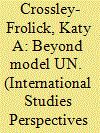| Srl | Item |
| 1 |
ID:
097070


|
|
|
|
|
| Publication |
2010.
|
| Summary/Abstract |
The Model United Nations format is one of the most popular active learning techniques to teach students about the evolving system of global governance and the limits of international organizations. In a world where the UN must cooperate with a variety of actors in the international system to address global challenges, students can benefit from simulations that draw on the intergovernmental Model United Nations format, but move beyond it to explore the complexities of negotiation involving state and nonstate actors. This paper discusses the use and development of a simulation for an upper-level international organization course loosely modeled on the XV International AIDS Conference held in Bangkok, Thailand in July 2004. It explores the value of the simulation, including learning objectives and expectations, student preparation in advance of the simulation, post-simulation debriefing, and an assessment of how the simulation can be modified and made more effective.
|
|
|
|
|
|
|
|
|
|
|
|
|
|
|
|
| 2 |
ID:
120822


|
|
|
|
|
| Publication |
2013.
|
| Summary/Abstract |
While global politics simulations have great potential to produce deeper learning of international affairs and IR theories and to promote the further development of technical skills, there are a variety of simulations to choose from, each with its own advantages and disadvantages for student learning. This paper engages in a comparative analysis of five distinct simulation types to examine the ways in which structural differences grant instructors more or less control over the learning environment. The five simulation types are the following: credit- and noncredit-bearing Model United Nations activities, hybrid Model UN activities, extended-in class simulations of real global actors and problems, and extended in-class simulations of fabricated global systems. The paper then considers the distinct opportunities for content, experiential, and theoretical learning within each simulation type.
|
|
|
|
|
|
|
|
|
|
|
|
|
|
|
|